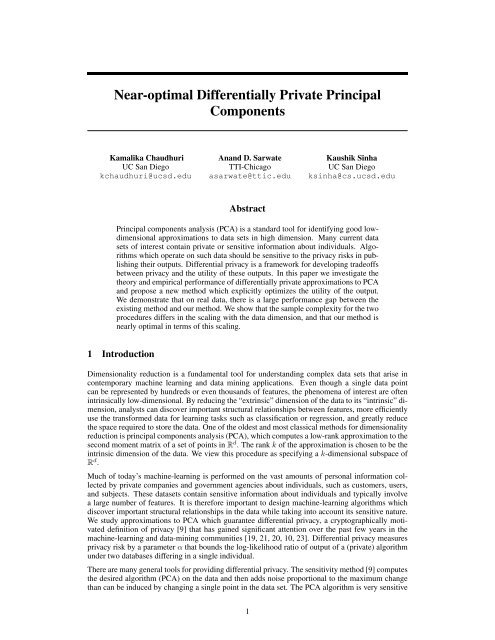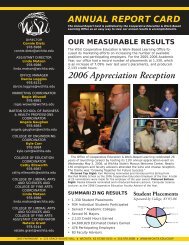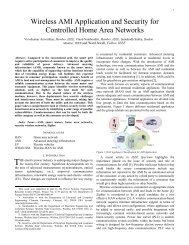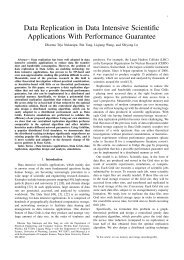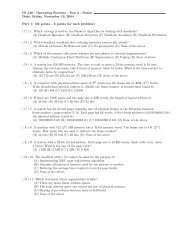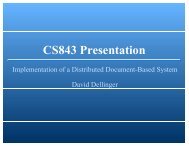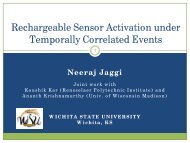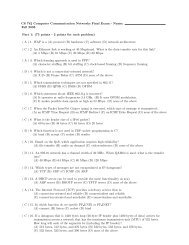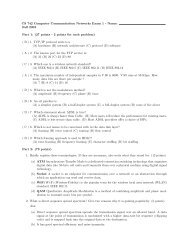Near-optimal Differentially Private Principal Components - NIPS
Near-optimal Differentially Private Principal Components - NIPS
Near-optimal Differentially Private Principal Components - NIPS
Create successful ePaper yourself
Turn your PDF publications into a flip-book with our unique Google optimized e-Paper software.
<strong>Near</strong>-<strong>optimal</strong> <strong>Differentially</strong> <strong>Private</strong> <strong>Principal</strong><strong>Components</strong>Kamalika ChaudhuriUC San Diegokchaudhuri@ucsd.eduAnand D. SarwateTTI-Chicagoasarwate@ttic.eduKaushik SinhaUC San Diegoksinha@cs.ucsd.eduAbstract<strong>Principal</strong> components analysis (PCA) is a standard tool for identifying good lowdimensionalapproximations to data sets in high dimension. Many current datasets of interest contain private or sensitive information about individuals. Algorithmswhich operate on such data should be sensitive to the privacy risks in publishingtheir outputs. Differential privacy is a framework for developing tradeoffsbetween privacy and the utility of these outputs. In this paper we investigate thetheory and empirical performance of differentially private approximations to PCAand propose a new method which explicitly optimizes the utility of the output.We demonstrate that on real data, there is a large performance gap between theexisting method and our method. We show that the sample complexity for the twoprocedures differs in the scaling with the data dimension, and that our method isnearly <strong>optimal</strong> in terms of this scaling.1 IntroductionDimensionality reduction is a fundamental tool for understanding complex data sets that arise incontemporary machine learning and data mining applications. Even though a single data pointcan be represented by hundreds or even thousands of features, the phenomena of interest are oftenintrinsically low-dimensional. By reducing the “extrinsic” dimension of the data to its “intrinsic” dimension,analysts can discover important structural relationships between features, more efficientlyuse the transformed data for learning tasks such as classification or regression, and greatly reducethe space required to store the data. One of the oldest and most classical methods for dimensionalityreduction is principal components analysis (PCA), which computes a low-rank approximation to thesecond moment matrix of a set of points in R d . The rank k of the approximation is chosen to be theintrinsic dimension of the data. We view this procedure as specifying a k-dimensional subspace ofR d .Much of today’s machine-learning is performed on the vast amounts of personal information collectedby private companies and government agencies about individuals, such as customers, users,and subjects. These datasets contain sensitive information about individuals and typically involvea large number of features. It is therefore important to design machine-learning algorithms whichdiscover important structural relationships in the data while taking into account its sensitive nature.We study approximations to PCA which guarantee differential privacy, a cryptographically motivateddefinition of privacy [9] that has gained significant attention over the past few years in themachine-learning and data-mining communities [19, 21, 20, 10, 23]. Differential privacy measuresprivacy risk by a parameter ↵ that bounds the log-likelihood ratio of output of a (private) algorithmunder two databases differing in a single individual.There are many general tools for providing differential privacy. The sensitivity method [9] computesthe desired algorithm (PCA) on the data and then adds noise proportional to the maximum changethan can be induced by changing a single point in the data set. The PCA algorithm is very sensitive1
in this sense because the top eigenvector can change by 90 by changing one point in the data set.Relaxations such as smoothed sensitivity [24] are difficult to compute in this setting as well. TheSULQ method of Blum et al. [2] adds noise to the second moment matrix and then runs PCA onthe noisy matrix. As our experiments show, the amount of noise required is often quite severe andSULQ seems impractical for data sets of moderate size.The general SULQ method does not take into account the quality of approximation to the nonprivatePCA output. We address this by proposing a new method, PPCA, that is an instance of theexponential mechanism of McSherry and Talwar [22]. For any k
we have A (1) = 1 (A)v 1 v1 T , where v 1 is the eigenvector corresponding to 1 (A). We refer to v 1 asthe top eigenvector of the data. For a d ⇥ k matrix ˆV with orthonormal columns, the quality of ˆV inapproximating A can be measured byq F ( ˆV )=tr⇣ˆV T A ˆV⌘. (3)The ˆV which maximizes q( ˆV ) has columns equal to {v i : i 2 [k]}, corresponding to the top keigenvectors of A.Our theoretical results apply to the special case k =1. For these results, we measure the innerproduct between the output vector ˆv 1 and the true top eigenvector v 1 :q A (ˆv 1 )=|hˆv 1 ,v 1 i| . (4)This is related to (3). If we write ˆv 1 in the basis spanned by {v i }, thenq F (ˆv 1 )= 1 q A (ˆv 1 ) 2 +dXi=2ihˆv 1 ,v i i 2 .Our proof techniques use the geometric properties of q A (·).Definition 2. A randomized algorithm A(·) is an (⇢, ⌘)-close approximation to the top eigenvectorif for all data sets D of n points,where the probability is taken over A(·).P (q A (A(D)) ⇢) 1 ⌘, (5)We study approximations to  that preserve the privacy of the underlying data. The notion ofprivacy that we use is differential privacy, which quantifies the privacy guaranteed by a randomizedalgorithm P applied to a data set D.Definition 3. An algorithm A(B) taking values in a set T provides ↵-differential privacy ifsupSµ (S |B= D)supD,D 0 µ (S |B= D 0 ) apple e↵ , (6)where the first supremum is over all measurable S ✓ T , the second is over all data sets D andD 0 differing in a single entry, and µ(·|B) is the conditional distribution (measure) on T induced bythe output A(B) given a data set B. The ratio is interpreted to be 1 whenever the numerator anddenominator are both 0.Definition 4. An algorithm A(B) taking values in a set T provides (↵, )-differential privacy ifP (A(D) 2S) apple e ↵ P (A(D 0 ) 2S)+ , (7)for all all measurable S✓T and all data sets D and D 0 differing in a single entry.Here ↵ and are privacy parameters, where low ↵ and ensure more privacy. For more details aboutthese definitions, see [9, 26, 8]. The second privacy guarantee is weaker; the parameter bounds theprobability of failure, and is typically chosen to be quite small.In this paper we are interested in proving results on the sample complexity of differentially privatealgorithms that approximate PCA. That is, for a given ↵ and ⇢, how large must the number ofindividuals n in the data set be such that it is ↵-differentially private and also a (⇢, ⌘)-close approximationto PCA? It is well known that as the number of individuals n grows, it is easier to guaranteethe same level of privacy with relatively less noise or perturbation, and therefore the utility of theapproximation also improves. Our results characterize how privacy and utility scale with n and thetradeoff between them for fixed n.Related Work Differential privacy was proposed by Dwork et al. [9], and has spawned an extensiveliterature of general methods and applications [1, 21, 27, 6, 24, 3, 22, 10] Differential privacyhas been shown to have strong semantic guarantees [9, 17] and is resistant to many attacks [12] thatsucceed against some other definitions of privacy. There are several standard approaches for designingdifferentially-private data-mining algorithms, including input perturbation [2], output perturbation[9], the exponential mechanism [22], and objective perturbation [6]. To our knowledge, other3
than SULQ method [2], which provides a general differentially-private input perturbation algorithm,this is the first work on differentially-private PCA. Independently, [14] consider the problemof differentially-private low-rank matrix reconstruction for applications to sparse matrices; providedcertain coherence conditions hold, they provide an algorithm for constructing a rank 2k approximationB to a matrix A such that kA Bk F is O(kA A k k) plus some additional terms whichdepend on d, k and n; here A k is the best rank k approximation to A. Because of their additionalassumptions, their bounds are generally incomparable to ours, and our bounds are superior for densematrices.The data-mining community has also considered many different models for privacy-preserving computation– see Fung et al. for a survey with more references [11]. Many of the models used havebeen shown to be susceptible to composition attacks, when the adversary has some amount of priorknowledge [12]. An alternative line of privacy-preserving data-mining work [28] is in the SecureMultiparty Computation setting; one work [13] studies privacy-preserving singular value decompositionin this model. Finally, dimension reduction through random projection has been consideredas a technique for sanitizing data prior to publication [18]; our work differs from this line of workin that we offer differential privacy guarantees, and we only release the PCA subspace, not actualdata. Independently, Kapralov and Talwar [16] have proposed a dynamic programming algorithmfor differentially private low rank matrix approximation which involves sampling from a distributioninduced by the exponential mechanism. The running time of their algorithm is O(d 6 ), where d isthe data dimension.3 Algorithms and resultsIn this section we describe differentially private techniques for approximating (2). The first is a modifiedversion of the SULQ method [2]. Our new algorithm for differentially-private PCA, PPCA,is an instantiation of the exponential mechanism due to McSherry and Talwar [22]. Both proceduresprovide differentially private approximations to the top-k subspace: SULQ provides (↵, )-differential privacy and PPCA provides ↵-differential privacy.Input perturbation. The only differentially-private approximation to PCA prior to this work isthe SULQ method [2]. The SULQ method perturbs each entry of the empirical second moment matrixA to ensure differential privacy and releases the top k eigenvectors of this perturbed matrix. Inparticular, SULQ recommends adding a matrix N of i.i.d. Gaussian noise of variance 8d2 log 2 (d/ )n 2 ↵and applies the PCA algorithm to A + N. This guarantees a weaker privacy definition known 2as(↵, )-differential privacy. One problem with this approach is that with probability 1 the matrixA + N is not symmetric, so the largest eigenvalue may not be real and the entries of the correspondingeigenvector may be complex. Thus the SULQ algorithm is not a good candidate for practicalprivacy-preserving dimensionality reduction.However, a simple modification to the basic SULQ approach does guarantee (↵, ) differentialprivacy. Instead of adding a asymmetric Gaussian matrix, the algorithm can add the a symmetricmatrix with i.i.d. Gaussian entries N. That is, for 1 apple i apple j apple d, the variable N ij is an independentGaussian random variable with variance2 . Note that this matrix is symmetric but not necessarilypositive semidefinite, so some eigenvalues may be negative but the eigenvectors are all real. Aderivation for the noise variance is given in Theorem 1.Algorithm 1: Algorithm MOD-SULQ (input pertubation)inputs: d ⇥ n data matrix X, privacy parameter ↵, parameteroutputs: d ⇥ k matrix ˆV k =[ˆv 1 ˆv 2 ··· ˆv k ] with orthonormal columns1 Set A = 1 n XXT .;2 Set = d+1n↵r ⇣2 logentries are i.i.d. drawn from N 0, 2 .;3 Compute ˆV k = V k (A + N) according to (2). ;⌘d 2 +d2 p + p 12⇡ ↵n. Generate a d ⇥ d symmetric random matrix N whose4
PPCA to guarantee a certain level of privacy and accuracy. The sample complexity of PPCA ngrows linearly with the dimension d, inversely with ↵, and inversely with the correlation gap (1 ⇢)and eigenvalue gap 1 (A) 2(A).Theorem 3 (Sample complexity of PPCA). If n>then PPCA is a (⇢, ⌘)-close approximation to PCA.⇣dlog(1/⌘)↵(1 ⇢)( 1 2) d+ log⌘4 1(1 ⇢ 2 )( 1 2),Our second result shows a lower bound on the number of samples required by any ↵-differentiallyprivatealgorithm to guarantee a certain level of accuracy for a large class of datasets, and uses prooftechniques in [4, 5].Theorem⇣4 (Sample complexity⌘lower bound). Fix d, ↵, apple 1 2and let 1 =ln 8+ln(1+exp(d))1exp 2 ·d 2. For any ⇢ 116, no ↵-differentially private algorithm A canapproximate PCA with expected utility greater ⇢ than ⇢ on all databases with n points in dimension dqdhaving eigenvalue gap , where n
0.70.60.60.5Utility0.50.40.3AlgorithmNonprivatePPCARandomUtility0.40.3AlgorithmNonprivatePPCARandom0.2SULQ0.2SULQ0.10.150000 100000 150000n2e+04 4e+04 6e+04 8e+04 1e+05n(a) census(b) kddcup0.50.5Utility0.40.3AlgorithmNonprivatePPCARandomSULQUtility0.40.30.2AlgorithmNonprivatePPCARandomSULQ0.20.12e+04 4e+04 6e+04 8e+04 1e+05n2000 4000 6000 8000 10000n(c) localization(d) insuranceFigure 1: Utility q F(U) for the four data setsNon-private PCA PPCA MOD-SULQ Random projectionsKDDCUP 98.97 ± 0.05 98.95 ± 0.05 98.18 ± 0.65 98.23 ± 0.49LOCALIZATION 100 ± 0 100 ± 0 97.06 ± 2.17 96.28 ± 2.34Table 1: Classification accuracy in the k-dimensional subspaces for kddcup99(k = 4), andlocalization(k =10) in the k-dimensional subspaces reported by the different algorithms.The plots show that PPCA always outperforms MOD-SULQ, and approaches the performance ofnon-private PCA with increasing sample size. By contrast, for most of the problems and samplesizes considered by our experiments, MOD-SULQ does not perform much better than random projections.The only exception is localization, which has much lower dimension (44). Thisconfirms that MOD-SULQ does not scale very well with the data dimension d. The performance ofboth MOD-SULQ and PPCA improve as the sample size increases; the improvement is faster forPPCA than for MOD-SULQ. However, to be fair, MOD-SULQ is simpler and hence runs fasterthan PPCA. At the sample sizes in our experiments, the performance of non-private PCA does notimprove much with a further increase in samples. Our theoretical results suggest that the performanceof differentially private PCA cannot be significantly improved over these experiments.Effect of privacy on classification. A common use of a dimension reduction algorithm is as aprecursor to classification or clustering; to evaluate the effectiveness of the different algorithms,we projected the data onto the subspace output by the algorithms, and measured the classificationaccuracy using the projected data. The classification results are summarized in Table 4. We chosethe normal vs. all classification task in kddcup99, and the falling vs. all classification task inlocalization. 1 We used a linear SVM for all classification experiments.For the classification experiments, we used half of the data as a holdout set for computing a projectionsubspace. We projected the classification data onto the subspace computed based on the holdoutset; 10% of this data was used for training and parameter-tuning, and the rest for testing. We repeatedthe classification process 5 times for 5 different (random) projections for each algorithm, andthen ran the entire procedure over 5 random permutations of the data. Each value in the figure isthus an average over 5 ⇥ 5 = 25 rounds of classification.1 For the other two datasets, census and insurance, the classification accuracy of linear SVM after(non-private) PCAs is as low as always predicting the majority label.7
0.7●●●●●Utility versus privacy parameter●●●● ● ●Utility q(U)0.60.50.4●●AlgorithmNon−<strong>Private</strong>SULQPPCA 10000.30.2●● ●0.5 1.0 1.5 2.0Privacy parameter alphaFigure 2: Plot of q F(U) versus ↵ for a synthetic data set with n =5,000, d =10, and k =2.The classification results show that our algorithm performs almost as well as non-private PCA forclassification in the top k PCA subspace, while the performance of MOD-SULQ and random projectionsare a little worse. The classification accuracy while using MOD-SULQ and random projectionsalso appears to have higher variance compared to our algorithm and non-private PCA; this can beexplained by the fact that these projections tend to be farther from the PCA subspace, in which thedata has higher classification accuracy.Effect of the privacy requirement. To check the effect of the privacy requirement,we generated a synthetic data set of n = 5,000 points drawn from a Gaussian distributionin d = 10 with mean 0 and whose covariance matrix had eigenvalues{0.5, 0.30, 0.04, 0.03, 0.02, 0.01, 0.004, 0.003, 0.001, 0.001}. In this case the space spanned by thetop two eigenvectors has most of the energy, so we chose k =2and plotted the utility q F (·) for nonprivatePCA, MOD-SULQ with =0.05, and PPCA. We drew 100 samples from each privacypreservingalgorithm and the plot of the average utility versus ↵ is shown in Figure 2. As ↵ increases,the privacy requirement is relaxed and both MOD-SULQ and PPCA approach the utility of PCAwithout privacy constraints. However, for moderate ↵ the PPCA still captures most of the utility,whereas the gap between MOD-SULQ and PPCA becomes quite large.5 ConclusionIn this paper we investigated the theoretical and empirical performance of differentially private approximationsto PCA. Empirically, we showed that MOD-SULQ and PPCA differ markedly in howwell they approximate the top-k subspace of the data. The reason for this, theoretically, is that thesample complexity of MOD-SULQ scales with d 3/2p log d whereas PPCA scales with d. BecausePPCA uses the exponential mechanism with q F (·) as the utility function, it is not surprising thatit performs well. However, MOD-SULQ often had a performance comparable to random projections,indicating that the real data sets we used were too small for it to be effective. We furthermoreshowed that PPCA is nearly <strong>optimal</strong>, in that any differentially private approximation to PCA mustuse ⌦(d) samples.Our investigation brought up many interesting issues to consider for future work. The description ofdifferentially private algorithms assume an ideal model of computation : real systems require additionalsecurity assumptions that have to be verified. The difference between truly random noise andpseudorandomness and the effects of finite precision can lead to a gap between the theoretical idealand practice. Numerical optimization methods used in objective perturbation [6] can only produceapproximate solutions, and have complex termination conditions unaccounted for in the theoreticalanalysis. Our MCMC sampling has this flavor : we cannot sample exactly from the Bingham distributionbecause we must determine the Gibbs sampler’s convergence empirically. Accounting forthese effects is an interesting avenue for future work that can bring theory and practice together.Finally, more germane to the work on PCA here is to prove sample complexity results for general krather than the case k =1here. For k =1the utility functions q F (·) and q A (·) are related, but forgeneral k it is not immediately clear what metric best captures the idea of “approximating” PCA.Developing a framework for such approximations is of interest more generally in machine learning.8
References[1] BARAK, B.,CHAUDHURI, K.,DWORK, C.,KALE, S.,MCSHERRY, F., AND TALWAR, K. Privacy,accuracy, and consistency too: a holistic solution to contingency table release. In PODS (2007), pp. 273–282.[2] BLUM, A.,DWORK, C.,MCSHERRY, F.,AND NISSIM, K. Practical privacy: the SuLQ framework. InPODS (2005), pp. 128–138.[3] BLUM, A.,LIGETT, K.,AND ROTH, A. A learning theory approach to non-interactive database privacy.In STOC (2008), R. E. Ladner and C. Dwork, Eds., ACM, pp. 609–618.[4] CHAUDHURI, K.,AND HSU, D. Sample complexity bounds for differentially private learning. In COLT(2011).[5] CHAUDHURI, K.,AND HSU, D. Convergence rates for differentially private statistical estimation. InICML (2012).[6] CHAUDHURI, K.,MONTELEONI, C.,AND SARWATE, A. D. <strong>Differentially</strong> private empirical risk minimization.Journal of Machine Learning Research 12 (March 2011), 1069–1109.[7] CHIKUSE, Y.Statistics on Special Manifolds. No. 174 in Lecture Notes in Statistics. Springer, New York,2003.[8] DWORK, C.,KENTHAPADI, K.,MCSHERRY, F.,MIRONOV, I.,AND NAOR, M. Our data, ourselves:Privacy via distributed noise generation. In EUROCRYPT (2006), vol. 4004, pp. 486–503.[9] DWORK, C.,MCSHERRY, F.,NISSIM, K.,AND SMITH, A. Calibrating noise to sensitivity in privatedata analysis. In 3rd IACR Theory of Cryptography Conference, (2006), pp. 265–284.[10] FRIEDMAN, A.,AND SCHUSTER, A. Data mining with differential privacy. In KDD (2010), pp. 493–502.[11] FUNG, B.C.M.,WANG, K.,CHEN, R.,AND YU, P. S. Privacy-preserving data publishing: A surveyof recent developments. ACM Comput. Surv. 42, 4 (June 2010), 53 pages.[12] GANTA, S.R.,KASIVISWANATHAN, S.P.,AND SMITH, A. Composition attacks and auxiliary informationin data privacy. In KDD (2008), pp. 265–273.[13] HAN, S.,NG, W.K., AND YU, P. Privacy-preserving singular value decomposition. In ICDE (292009-april 2 2009), pp. 1267 –1270.[14] HARDT, M.,AND ROTH, A. Beating randomized response on incoherent matrices. In STOC (2012).[15] HOFF, P. D. Simulation of the matrix Bingham-von Mises-Fisher distribution, with applications to multivariateand relational data. J. Comp. Graph. Stat. 18, 2 (2009), 438–456.[16] KAPRALOV, M.,AND TALWAR, K. On differentially private low rank approximation. In Proc. of SODA(2013).[17] KASIVISWANATHAN, S.P., AND SMITH, A. A note on differential privacy: Defining resistance toarbitrary side information. CoRR abs/0803.3946 (2008).[18] LIU, K.,KARGUPTA, H.,AND RYAN, J. Random projection-based multiplicative data perturbation forprivacy preserving distributed data mining. IEEE Trans. Knowl. Data Eng. 18, 1 (2006), 92–106.[19] MACHANAVAJJHALA, A.,KIFER, D.,ABOWD, J.M.,GEHRKE, J., AND VILHUBER, L. Privacy:Theory meets practice on the map. In ICDE (2008), pp. 277–286.[20] MCSHERRY, F. Privacy integrated queries: an extensible platform for privacy-preserving data analysis.In SIGMOD Conference (2009), pp. 19–30.[21] MCSHERRY, F.,AND MIRONOV, I. <strong>Differentially</strong> private recommender systems: Building privacy intothe netflix prize contenders. In KDD (2009), pp. 627–636.[22] MCSHERRY, F.,AND TALWAR, K. Mechanism design via differential privacy. In FOCS (2007), pp. 94–103.[23] MOHAMMED, N.,CHEN, R.,FUNG, B.C.M.,AND YU, P. S. <strong>Differentially</strong> private data release fordata mining. In KDD (2011), pp. 493–501.[24] NISSIM, K.,RASKHODNIKOVA, S.,AND SMITH, A. Smooth sensitivity and sampling in private dataanalysis. In STOC (2007), D. S. Johnson and U. Feige, Eds., ACM, pp. 75–84.[25] STEWART, G. On the early history of the singular value decomposition. SIAM Review 35, 4 (1993),551–566.[26] WASSERMAN, L.,AND ZHOU, S. A statistical framework for differential privacy. JASA 105, 489 (2010).[27] WILLIAMS, O.,AND MCSHERRY, F. Probabilistic inference and differential privacy. In <strong>NIPS</strong> (2010).[28] ZHAN, J.Z.,AND MATWIN, S. Privacy-preserving support vector machine classification. IJIIDS 1, 3/4(2007), 356–385.9


